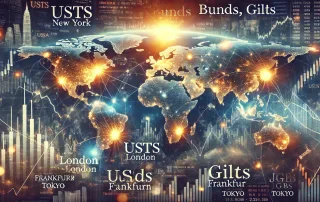Middle East Geopolitics: How Tensions Shake the Forex Market

The Unseen Hands Behind the Middle East Drama: How Geopolitics Could Shake Up Your Forex Trades
The world of trading isn’t just about watching charts and reading numbers. Sometimes, it’s about keeping an eye on the people behind the curtains—those making moves that could turn your positions into either profit or pain. And right now, that drama is unfolding in the Middle East. This isn’t your average international squabble; it’s a series of chess moves that could sway currency values and ripple through your portfolio faster than you can say “buy low, sell high.” So, let’s break it down in a way that both enlightens and entertains.
Beirut Bombshell: What It Means for Traders
Imagine this—you’re out shopping online, clicking away, only to find out that you just bought the wrong size shoes. Now, instead of refunding, your delivery guy decides to play a game of dodgeball with your doorstep. Well, this sums up the current dance between Israel and Hezbollah. The latest? Israel just launched a strike on central Beirut. It’s all part of a broader conflict that Lebanon and Hezbollah are trying to wind down with a ceasefire. Yet, here comes Israeli PM Netanyahu, making it crystal clear that he won’t stop the operations against Hezbollah, ceasefire or not. Yes, that’s the “wrong-size shoes” type of situation we’re talking about—the kind that just doesn’t fit the peace package.
For traders, these moves are like a sudden swerve on a seemingly smooth highway. The Lebanese pound’s value is on shaky ground, and with Israel involved, the ripple effect can drag in neighboring currencies too. The shekel might twitch, oil prices may do the tango, and overall, there’s a lot of potential chaos on the Forex dance floor. Remember, in geopolitical Forex trading, predicting market moves often feels like trying to anticipate who’ll be asked to leave the party next.
Hezbollah’s Ceasefire and Your Trading Moves: Reading Between the Bombshells
Alright, let’s get real—Hezbollah, a group known for its “tense-neighborly love” approach, has just agreed to a ceasefire with Israel. Sort of. Apparently, they agreed “with some comments”, which in diplomat-speak probably means “we have a list of grievances as long as the Eiffel Tower, but we’ll give it a shot.” So, where does this leave Forex traders? Well, the market reaction to ceasefire attempts is often like that one indecisive friend at a dinner party—never quite sure whether to stay or leave. But here’s where you, as a trader, can shine.
Ceasefire news generally means a little calm—just enough to let traders take a breather. However, this “calm” is usually fraught with complexities, like a popcorn maker that doesn’t know when to stop. What’s the move? Keep an eye on that U.S. dollar against Middle Eastern currencies, because that’s where a lot of traders miss opportunities. The shekel, for example, might gain some strength, but the Lebanese pound? Probably going to remain as shaky as a two-legged chair.
The U.S. Chess Game: How Diplomacy Affects the Market
Enter the U.S., ready to play the diplomat, waving around ceasefire proposals and stirring the pot. In fact, we just heard that the U.S. envoy Amos Hochstein is heading over to Beirut for more negotiations. Picture this: Hochstein gets there, tries to bring both sides closer, while at the same time, Israel’s Foreign Minister is asking the U.N. to squeeze Iraq—that’s like trying to make peace at a neighbor’s party while someone else across town is throwing rocks through your windows. It’s complex.
Now, for Forex traders, what this means is a multi-pronged opportunity. The U.S. dollar often plays the role of “the calm in the storm” whenever geopolitical tensions flare up—people flock to it like it’s some kind of safety raft. But here’s where your next-level strategy comes in. Look for emerging patterns in how these talks progress. If tensions escalate further, we could see a continued rise in commodities like oil—and when oil prices jump, the Canadian dollar, often referred to as a petrocurrency, gets a boost. This is where contrarian perspectives can pay off, especially if you’re keeping an eye on shifts in global oil prices.
Iran vs. Sanctions: The Forex Ripple Effect
The sanctions game—the most predictable-yet-unpredictable tool in the international playbook. The EU and UK have slapped more sanctions on Iran, and Iran’s response? Something along the lines of, “Baseless and unjustified.” But what does that mean for us traders? For starters, it highlights a fragile environment where any misstep could spike oil prices. Keep this on your radar because, as Iran gets squeezed, they could potentially mess around with the Strait of Hormuz, that very narrow route for 20% of the world’s oil supply. Even the smallest signal that something might happen here can send shockwaves through the energy market.
For you as a trader, the impact isn’t just oil; it’s the whole currency chain reaction. Consider currencies of countries heavily dependent on oil imports or exports—the Japanese yen, for instance. Japan relies heavily on Middle Eastern oil, and any major price hike will almost certainly weaken the yen. Play this right, and you’re looking at some serious opportunities for currency pairs like USD/JPY or CAD/JPY.
Underground Strategy Spotlight: Looking Beyond the Headlines
Here’s where the hidden gem comes in: leverage market sentiment data. When news like this hits, most traders react emotionally—the sell-offs, the knee-jerk buys, it all creates a rush that often blinds people from deeper opportunities. Instead of playing on sentiment alone, use sentiment as a setup for contrarian trades. If everyone is flocking to the dollar as a safe haven, look for those undervalued currency pairs that might be benefiting indirectly, or prepare for an eventual return once the storm subsides.
Consider using economic indicators to look beyond the obvious. For example, if Israel and Hezbollah reach a ceasefire, look at economic activity indices in the region. If production picks up again or cross-border trade shows signs of normalization, the undervalued Lebanese pound might be poised for a comeback (albeit speculative).
How to Trade Smarter Amid Chaos
In times like these, geopolitics offers both peril and promise. Sure, it’s tough—like trying to juggle flaming torches while also giving someone a haircut. But these are also the moments when opportunities open up for traders with patience and a deeper understanding. Instead of following the emotional crowd, look at the fundamentals, look at the patterns, and consider how these actions impact broader economic flows.
Trading Forex amid geopolitical tensions means being two steps ahead—not just of the news, but of the traders who don’t take the time to think beyond the headlines. Your strategy, if executed correctly, isn’t just about making moves—it’s about turning chaos into calculated opportunities. Remember, while everyone else is busy reacting, you should be busy planning your next play.
So, what’s your move?
—————–
Image Credits: Cover image at the top is AI-generated

Anne Durrell
About the Author
StarseedFX delivers timely Forex news and market insights, thoughtfully edited and curated by Anne Durrell. As a seasoned Forex expert with over 12 years of industry experience, Anne turns complex market shifts into clear, engaging, and easy-to-understand updates.
From decoding the latest trends to writing her own in-depth analyses, Anne ensures every piece is both informative and enjoyable. If you found this article helpful, don’t forget to share it with fellow traders and friends, and leave a comment below—your insights make the conversation even richer! Follow StarseedFX for fresh updates and stay ahead in the dynamic world of Forex trading.






